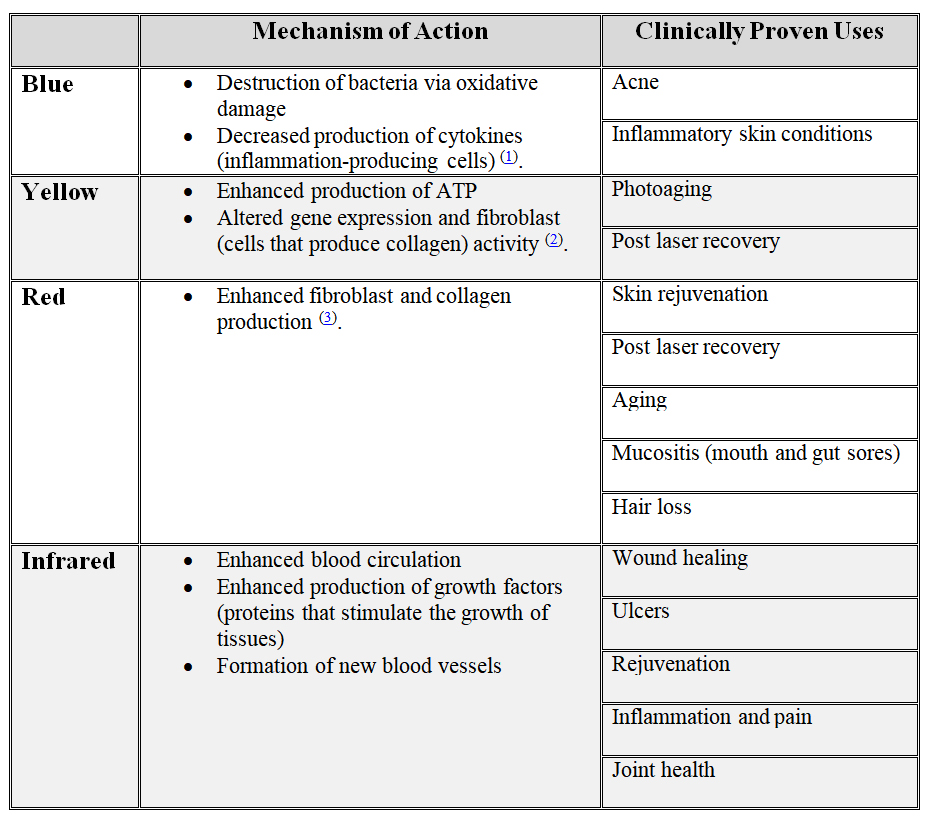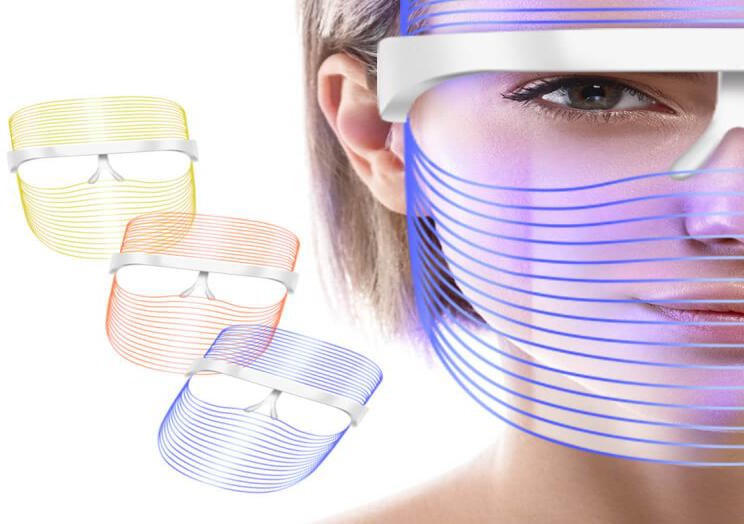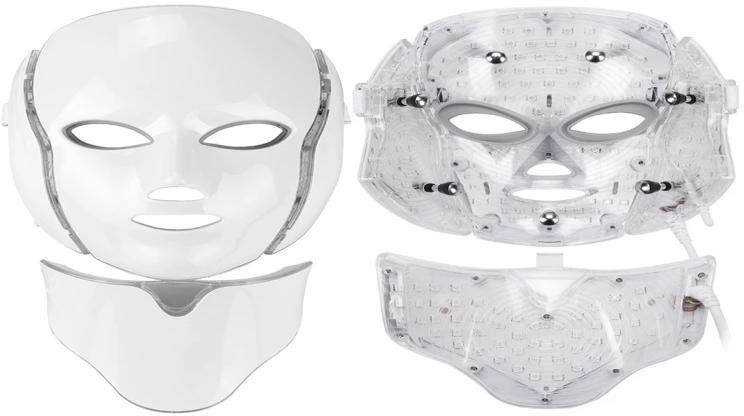Light-emitting diode (LED) therapy is trending in both aesthetician clinics and at home to treat a wide variety of medical and aesthetic disorders. It offers one of the safest and most effective tools in the maintenance of healthy-looking skin.
This article will explain all the facts about LED light therapy including what LED light therapy is, how this technology works, clinically proven applications, and what makes this technology effective for a wide implementation today.
What Is LED?
LED stands for light-emitting diode also called low-level laser or cold laser. It’s an artificial light-emitting technology that emits light when current flows through it.
This technology gives off bright light that mimics natural outdoor light.
Commercially available LED devices include blue, yellow, red, and infrared wavelengths that penetrate the skin at different depths.

What is LED Light Therapy?
LED light therapy is a medical & skincare therapy that uses multiple wavelengths of light including red, blue, yellow, and infrared, for producing safe biological effects at the cellular level anywhere on the body.
It is a painless, non-invasive skin treatment that keeps your skin youthful, alongside treating a variety of specific medical and skin concerns.
How LED Light Therapy Works?
Light therapy works by producing “photo biochemical effects” at the cellular level that results in:
- Enhanced production of ATP (ATP is the energy-carrying molecules found in all living things; with enhanced production of ATP a cell can produce more energy thus can function more proficiently, rejuvenate themselves, and repair damage).
- Enhanced collagen synthesis
- Enhanced activity of fibroblast (cells that produce collagen)
- Enhanced blood circulation
- Destruction of acne-causing bacteria
- Anti-inflammatory effects

Clinically Proven Applications of LED Light Therapy
Blue LED Therapy
- Treats Acne: Blue light directly kills acne-causing bacteria. Multiple research studies on patients with mild-to-moderate acne concluded that blue LED therapy is highly effective in reducing the number of inflamed lesions (4)(5)(6)(7)(8)(9). It also targets sebaceous glands that produce oil and make them less active which in turn reduces acne breakouts.
- Treats Inflammatory Skin Conditions: Blue light also produces strong anti- inflammatory effects thus help treat different inflammatory skin conditions e.g. eczema
(10).
Yellow LED Therapy
- Post Laser Recovery: Laser is the most aggressive form of light therapy with many side effects. Multiple research studies claimed that yellow LED can reduce the intensity and duration of erythema/skin rash (a common side effect of laser treatment) and its associated pain (11)(12).
- Reduces Photoaging: Yellow LED light has been also shown to reduce mild to moderate photoaging (13)(14).
Red LED Therapy
- Skin Rejuvenation: Red light stimulates collagen production; enhanced collagen production (15) reduces wrinkles and makes skin look smoother, fuller.
- Wound Healing: Red LED therapy help treat wounds including burns, skin grafts, amputation injuries, infected wounds, and trapping injuries (16).
- Post-laser Recovery: A study showed that red LED was helpful in post-laser recovery Moreover; it also promoted healing time in those patients who were suffering the side effects of laser treatment (17).
- Treats Mucositis (mouth and gut sores): Phototherapy with red LED has been shown positive effects on repairing and reducing the severity of canker sores (18).
- Promotes Hair Growth: Red LED is highly effective and safe to promote hair growth in both men and women (19)(20).
Infrared LED Therapy
- Treat Ulcers and Wounds: Infrared light can penetrate your deepest skin layer. It promotes dilation of blood vassals and thus increased blood flow. It also promotes wound healing by enhancing the production of growth factors (21). A study revealed that in patients with non-healing wounds, infrared LED therapy fastened wound healing along with decreased pain, infection, and swelling (22).
- Reduces Inflammation and Pain: In a clinical trial, Achilles tendinitis patients were subjected to infrared LED therapy. It’s a condition that causes pain along the back of the leg near the heel. The study concluded that infrared LED therapy reduces inflammation and pain in Achilles tendinitis’ patients (23).
Combinational LED Light Therapy
Multiple research studies indicated that combinational LED therapy is more effective than single LED light therapy (24)(25).
- Relieves Joint Pain & Disability: In a clinical study, elderly patients with knee osteoarthritis had received a combination of red & infrared LED therapy. The study concluded that it relieves joint pain and disability (26).
- Skin Rejuvenation: In another research study of 136 individuals in which individuals had received a combination of red and infrared LED therapy concluded that this therapy helps improve skin complexion, build collagen and reduce fine lines, wrinkles, and skin roughness (27).
- Mends Photo Damage: A study demonstrated that the combination of red and infrared LED therapy help to mend photo-damaged skin (28).
So far, a combination of blue, red, and infrared LED has been shown to greatest success as dermatological therapies for acne, psoriasis (skin disease), photodamage, fine lines, wrinkles, and scar appearance.
Benefits of LED Light Therapy
- Excellent Safety Profile: One of the greatest benefits of LED Light therapy is its safety record. According to research, LED Light therapy is safe (27). Compared to other anti- aging treatments such as chemical peels, laser therapy, and dermabrasion, LED therapy won’t cause skin burns and is safe for all skin colors and types.
- Suitable For Regular Use: Since Light Emitting diodes (LED) don’t use ultraviolet (UV) rays therefore this therapy won’t cause any skin damage and is safe for regular use.
- In-Home Therapy: Popular FDA-approved brands such as “Diode Light Therapy TM” introduced in-home LED Light therapy devices that provide direct, non-addictive, drug- free pain relief as well as skincare. For in-home therapy, you don’t need a healthcare provider except if you’ve eye problems or you take medicines that cause sensitivity to light.
- Can Be Used On Any Part Of Your Body: LED light therapy can be used on any part of your body. However, its most popular use is for the face as skin damage tends to occur to your face because it’s exposed to the elements more than other body parts.
Commercially Available LED Therapy Devices
Portable Torch: It’s an advanced combinational LED device with multiple purposes that is not only used for skincare but also helps in temporary relief of minor muscle & joint pain, arthritis, spasm, and stiffness.

Portable Mask: LED masks offer mono as well as combination light therapy. You can wear LED masks on your face for a few minutes each day. You can sit upright or lie down with these.


Helmet: The LED helmet is great for hair loss treatment in both men and women.

References & Resources
- Shnitkind, Elaine, et al. “Anti-inflammatory properties of narrow-band blue light.” Journal of drugs in dermatology: JDD 5.7 (2006): 605-610.
- McDaniel, D. H., et al. “Varying ratios of wavelengths in dual wavelength LED photomodulation alters gene expression profiles in human skin fibroblasts.” Lasers in surgery and medicine 42.6 (2010): 540-545.
- Barolet, Daniel, et al. “Regulation of skin collagen metabolism in vitro using a pulsed 660 nm LED light source: clinical correlation with a single-blinded study.” Journal of investigative dermatology 129.12 (2009): 2751-2759.
- Morton, C. A., et al. “An open study to determine the efficacy of blue light in the treatment of mild to moderate acne.” Journal of dermatological treatment 16.4 (2005): 219-223.
- Tremblay, J. F., et al. “Light‐emitting diode 415 nm in the treatment of inflammatory acne: An open‐label, multicentric, pilot investigation.” Journal of Cosmetic and Laser Therapy 8.1 (2006): 31-33.
- Gold, Michael H., Whitney Sensing, and Julie A. Biron. “Clinical efficacy of home-use blue-light therapy for mild-to moderate acne.” Journal of Cosmetic and Laser Therapy 13.6 (2011): 308-314.
- Wheeland, Ronald G., and Sunil Dhawan. “Evaluation of self-treatment of mild-to-moderate facial acne with a blue light treatment system.” Journal of drugs in dermatology: JDD 10.6 (2011): 596-602.
- Akaraphanth, R., W. Kanjanawanitchkul, and P. Gritiyarangsan. “Efficacy of ALA‐PDT vs blue light in the treatment of acne.” Photodermatology, photoimmunology & photomedicine 23.5 (2007): 186-190.
- Weinstabl, Antonia, et al. “Prospective randomized study on the efficacy of blue light in the treatment of psoriasis vulgaris.” Dermatology 223.3 (2011): 251-259.
- Shnitkind, Elaine, et al. “Anti-inflammatory properties of narrow-band blue light.” Journal of drugs in dermatology: JDD 5.7 (2006): 605-610.
- Alster, Tina S., and Rungsima Wanitphakdeedecha. “Improvement of postfractional laser erythema with light‐emitting diode photomodulation.” Dermatologic surgery 35.5 (2009): 813-815.
- Khoury, Jane G., and Mitchel P. Goldman. “Use of light‐emitting diode photomodulation to reduce erythema and discomfort after intense pulsed light treatment of photodamage.” Journal of cosmetic dermatology 7.1 (2008): 30-34.
- Weiss, Robert A., et al. “Clinical experience with light‐emitting diode (LED) photomodulation.” Dermatologic surgery 31 (2005): 1199-1205.
- Weiss, Robert A., et al. “A novel non-thermal non-ablative full panel LED photomodulation device for reversal of photoaging: digital microscopic and clinical results in various skin types.” Journal of drugs in dermatology: JDD 3.6 (2004): 605-610.
- Barolet, Daniel, et al. “Regulation of skin collagen metabolism in vitro using a pulsed 660 nm LED light source: clinical correlation with a single-blinded study.” Journal of investigative dermatology 129.12 (2009): 2751-2759.
- Hawkins, D., N. Houreld, and H. Abrahamse. “Low level laser therapy (LLLT) as an effective therapeutic modality for delayed wound healing.” Annals of the New York Academy of Sciences 1056.1 (2005): 486- 493.
- Trelles, Mario A., and Inés Allones. “Red light‐emitting diode (LED) therapy accelerates wound healing post‐blepharoplasty and periocular laser ablative resurfacing.” Journal of Cosmetic and Laser Therapy 8.1 (2006): 39-42.
- Campos, Luana, et al. “Phototherapy With LED as an Effective Treatment for Chemotherapy-Induced Oral Mucositis in Hamsters.” Journal of Lasers in Medical Sciences 11.4 (2020): 475.
- Avci, Pinar, et al. “Low‐level laser (light) therapy (LLLT) for treatment of hair loss.” Lasers in surgery and medicine 46.2 (2014): 144-151.
- Lanzafame, Raymond J., et al. “The growth of human scalp hair mediated by visible red light laser and LED sources in males.” Lasers in surgery and medicine 45.8 (2013): 487-495.
- Horwitz, Lon R., Thomas J. Burke, and Dale Carnegie. “Augmentation of wound healing using monochromatic infrared energy.” Adv Wound Care 12 (1999): 35-40.
- Hunter, Susan, et al. “The use of monochromatic infrared energy in wound management.” Advances in skin & wound care 20.5 (2007): 265-266.
- Bjordal, J. M., R. A. B. Lopes-Martins, and V. V. Iversen. “A randomised, placebo controlled trial of low level laser therapy for activated Achilles tendinitis with microdialysis measurement of peritendinous prostaglandin E2 concentrations.” British journal of sports medicine 40.1 (2006): 76-80.
- Lee, Seung Yoon, et al. “A prospective, randomized, placebo-controlled, double-blinded, and split-face clinical study on LED phototherapy for skin rejuvenation: clinical, profilometric, histologic, ultrastructural, and biochemical evaluations and comparison of three different treatment settings.” Journal of Photochemistry and Photobiology B: Biology 88.1 (2007): 51-67.
- Goldberg, David J., and Bruce A. Russell. “Combination blue (415 nm) and red (633 nm) LED phototherapy in the treatment of mild to severe acne vulgaris.” Journal of Cosmetic and Laser Therapy 8.2 (2006): 71-75.
- Stelian, Jean, et al. “Improvement of pain and disability in elderly patients with degenerative osteoarthritis of the knee treated with narrow‐band light therapy.” Journal of the American Geriatrics Society 40.1 (1992): 23-26.
- Wunsch, Alexander, and Karsten Matuschka. “A controlled trial to determine the efficacy of red and near- infrared light treatment in patient satisfaction, reduction of fine lines, wrinkles, skin roughness, and intradermal collagen density increase.” Photomedicine and laser surgery 32.2 (2014): 93-100.
- Goldberg, David J., et al. “Combined 633-nm and 830-nm led treatment of photoaging skin.” Journal of drugs in dermatology: JDD 5.8 (2006): 748-753.



